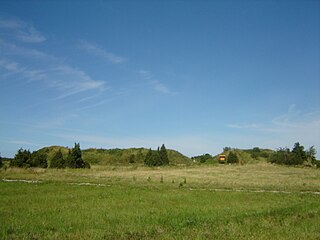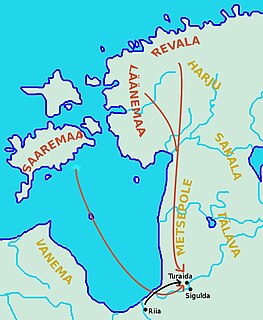 W
WThe Battle of Aizkraukle or Ascheraden was a battle fought on March 5, 1279, between the Grand Duchy of Lithuania, led by Traidenis, and the Livonian branch of the Teutonic Order near Aizkraukle in present-day Latvia. The order suffered a great defeat: 71 knights, including the grand master, Ernst von Rassburg, and Eilart Hoberg, leader of the knights from Danish Estonia, were killed. It was the second-largest defeat of the order in the 13th century. After this battle Duke Nameisis of the Semigallians recognized Traidenis as his suzerain.
 W
WThe Battle of Durbe was a medieval battle fought near Durbe, 23 km (14 mi) east of Liepāja, in present-day Latvia during the Livonian Crusade. On 13 July 1260, the Samogitians soundly defeated the joint forces of the Teutonic Knights from Prussia and Livonian Order from Livonia. Some 150 knights were killed, including Livonian Master Burchard von Hornhausen and Prussian Land Marshal Henrik Botel. It was by far the largest defeat of the knights in the 13th century: in the second-largest, the Battle of Aizkraukle, 71 knights were killed. The battle inspired the Great Prussian Uprising and the rebellions of the Semigallians, the Couronians, and the Oeselians. The battle undid two decades of Livonian conquests and it took some thirty years for the Livonian Order to restore its control.
 W
WThe Battle of Karuse or Battle on the Ice was fought on 16 February 1270 between the Grand Duchy of Lithuania and the Livonian Order on the frozen Baltic Sea between the island of Muhu and the mainland. The Lithuanians achieved a decisive victory. The battle, named after the village of Karuse, was the fifth-largest defeat of the Livonian or Teutonic Orders in the 13th century. Almost all that is known about the battle comes from the Livonian Rhymed Chronicle, which devoted 192 lines to the battle.
 W
WThe Battle of Lyndanisse was a battle during the Livonian Crusade, fought between the Kingdom of Denmark with various German allies and pagan Estonian tribes. The battle helped King Valdemar II of Denmark establish the territory of Danish Estonia during the Northern Crusades, which were undertaken in response to calls from the Pope. The Danes defeated the Estonians at Lindanise.
 W
WThe Battle of Muhu was a military engagement fought between a force of Baltic and Germanic crusaders and pagan Oeselians. The battle, fought in Muhu, Estonia, resulted in the crusaders storming and capturing a fortress held by the Oeselians.
 W
WThe Battle of Saule was fought on 22 September 1236, between the Livonian Brothers of the Sword and pagan troops of Samogitians and Semigallians. Between 48 and 60 knights were killed, including the Livonian Master, Volkwin. It was the earliest large-scale defeat suffered by the orders in Baltic lands. The Sword-Brothers, the first Catholic military order established in the Baltic lands, was soundly defeated and its remnants accepted incorporation into the Teutonic Order in 1237. The battle inspired rebellions among the Curonians, Semigallians, Selonians, Oeselians, tribes previously conquered by the Sword-Brothers. Some thirty years' worth of conquests on the left bank of Daugava were lost. To commemorate the battle, in 2000 the Lithuanian and Latvian parliaments declared September 22 to be the Baltic Unity Day.
 W
WBattle of Turaida was one of the biggest battles of Livonian crusade between Estonian tribes and Livonian Brothers of the Sword. The battle took place around modern Turaida, Latvia.